Dunk
Established
Tony Lovell and I are bothe members of Peterborough Photographic Society. Back in 2003 we were discussing the possibility of making a super long focus lens ie one in excess of 800mm. focal length. After exploring the Surplus Shed website http://www.surplusshed.com/ we saw some interesting ex govt. optics which seemed to offer some good potential. Tony subsequently bought a surplus flight simulator projector lens - an f3.2 11 inch diameter triplet of 36 inch focal length ie 914mm. I think it cost about £250 which at the time was considerably cheaper than any equivalent camera lens. In fact the only other lenses anywhere near this focal length were/are probably the 800mm Nikkors and Canons and 1000mm Pentax optics.
When the lens eventually arrived it weighed approx 20 pounds but there was obviously something not quite right with it. There were some very obvious Newton's rings visible which were indicative of possible balsam separation. However, when Tony took the lens apart he discovered that none of the elements were cemented but strangely, the separate elements were coated in oil. The oil was removed using alcohol and the elements reassembled into the original module.. Here is a picture of one of the 11 inch elements during the cleaning process.
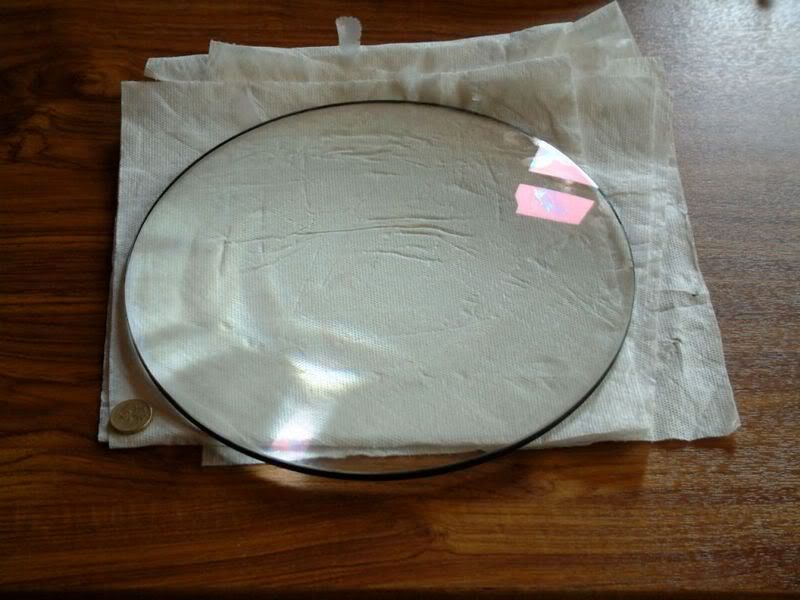
Tony works as a structural engineer and is thus an accomplished CAD designer. This is his initial lens mount drawing designed specifically for use with his Pentax 67 and large format 5 x 4 cameras. Note the attention to very adequate baffling throughout the lens barrel to reduce flare. Also note the very large lens hood to further reduce flare. The lens mount/barrel design parameters were established by trial and error by supporting the original lens module in front of a Pentax 67 camera whilst trying to focus on a distant church tower.
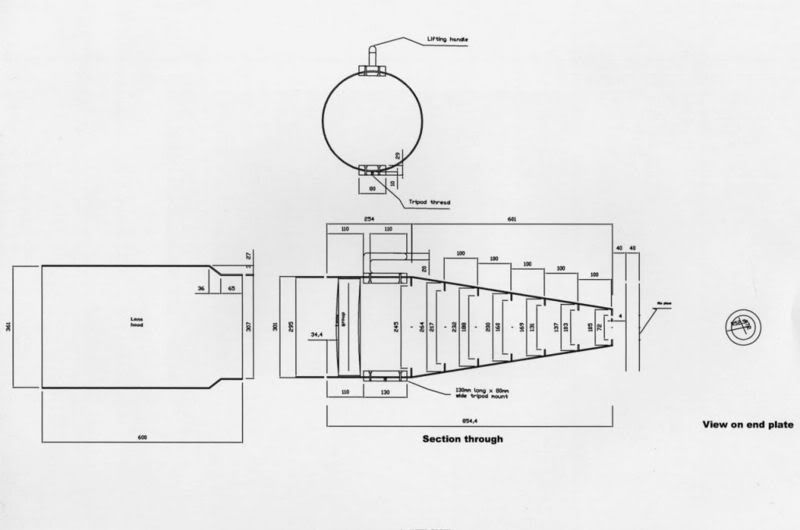
The drawing was submitted to local peterborough engineers MIDAS TECHNOLOGIES (GB) LTD a specialist aluminium fabrication company. This was the result including the natty clips for attaching the lens hood.

Tony then had to "flare-proof" the interior of the aluminium barrel . A stipple finish coating was achieved using Araldite epoxy resin sprinkled with grit. Here you see both the detachable lens hood and the lens barrel.
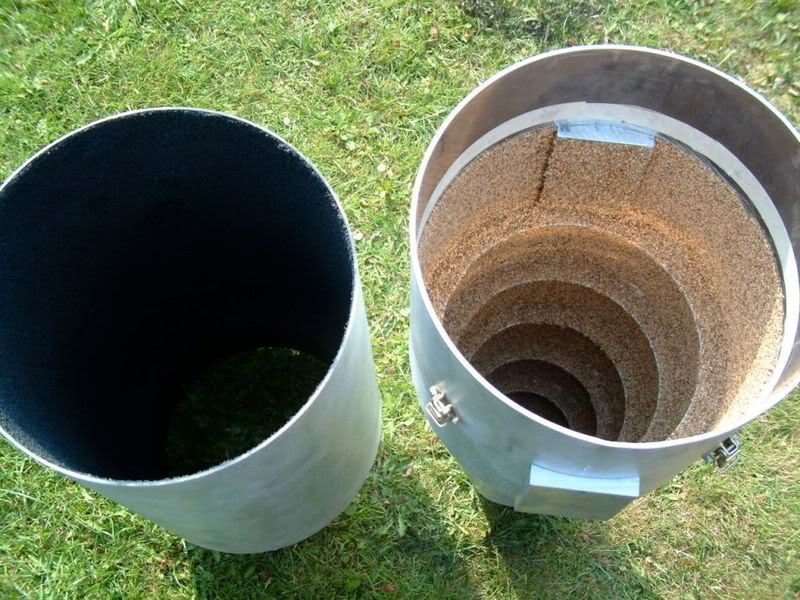
The stipple finish then received a coat of matt black spray barbeque paint

Next the exterior was given a coat of white paint and the 3 lens element module mounted inside the barrel. A Pentax 67 variable length extension tube was mounted on the rear of the lens for focusing purposes. This photo shows the Pentax 67 medium format camera mounted on the lens. Note the use of 2 tripods. The bulk of the resultant 59 pounds lens weight ( 46pounds plus 13 pounds for the hood) is supported by a fluid head on an ex BBC TV outside broadcast camera tripod. The second tripod supporting the camera body is essential to stabilize the whole set-up and neutralize the inevitable magnification of camera shake/shutter vibration inherent with such a long focus lens and medium format focal plane shutter. When Tony transports the behemoth plus 2 tripods to and from his Land Rover he uses a sack truck.

An iris diaphragm was also incorporated into the original design but the biggest obtainable was only wide enough to mount at the rear end of the lens barrel. Unfortunately it failed to work in that position apart from just vignetting the image. Here is a photo of same but it was subsequently abandoned. In its place Tony uses home-made Waterhouse stops cut out from fogged Xray film plates which are inserted between the hood and the front lens element . Waterhouse stops are fixed circular hole diaphragms as used in ancient Victorian large format plate film cameras.
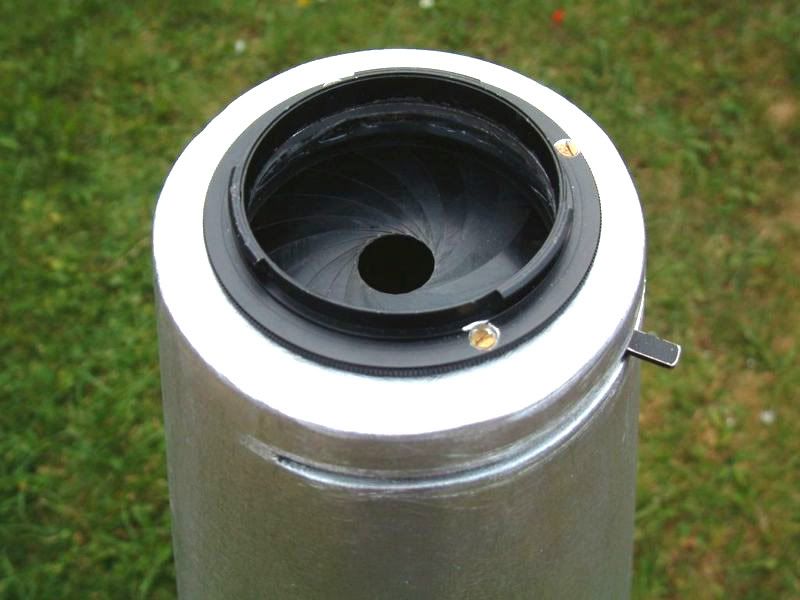
Tony took the camera and lens to Alexandra Palace for its first test where he took photographs of Canary Wharf and the Dome which are both approx 8.5 miles distant. As with all super long focus and telephoto lenses it can be difficult to obtain decent images of subjects several miles away because of atmospheric haze/dust . However, the results are pretty good especially considering this was Tony's first attempt at making such a lens . In the original copy of the Canary Wharf photo it is possible to read the HSBC logo on the top of the building.
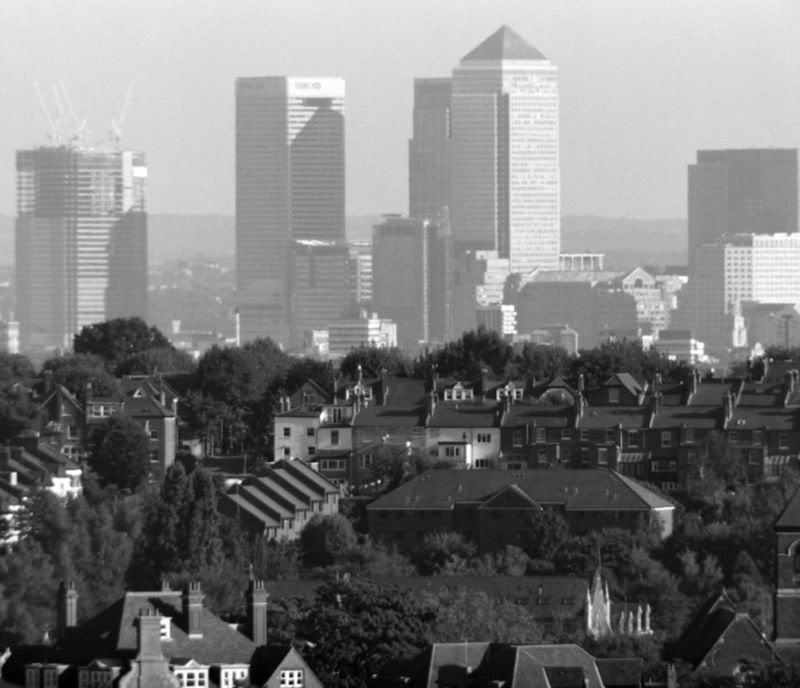
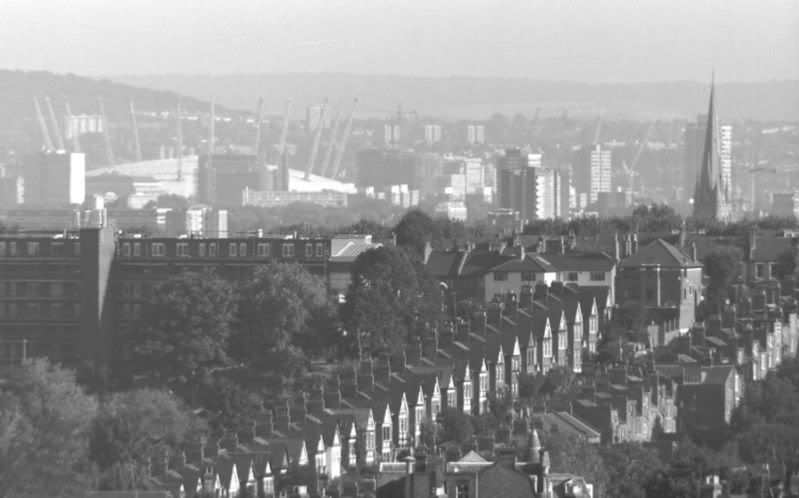
Another super long focus lens project is currently on the back burner. When finished it will be a 1600mm f10 lens which should be a bit more manageable because the front lens element is only 6.25 inches in diameter.
The lens cost ££hundreds to make but anything "off the shelf" would have cost ££thousands.
Tony is still experimenting with the lens and plans to adapt it for use with his Nikon D700. He is also planning to write a more comprehensive article and submit it for publication. These photos are his copyright so please treat as such. He has given me permission to reproduce them here.
Here is a moon photograph taken with the lens. A Pentax teleconverter may have been used with the lens for this photograph.

I don't think Tony has used the lens after a rainstorm yet. When he does the results should be better because there will be less atmospheric dust to penetrate. Note the difference in contrast in the above photographs between the far distant and intermediate distant buildings. The London atmospheric dust concentrations must vary greatly. Tony also tried the lens from the top of the Queensgate multi storey car park in Peterborough. When focusing down Bourges Boulevard the lens resolved sharp images of vehicle tax discs 200 metres distant. The lens is surprisingly sharp considering it has only three lens elements. And it is flare free thanks to the comprehensive baffling and internal barrel coating - and the relatively few lens elements compared to other types of design.
Tony and I are both fans of Andreas Feininger and his pioneering long focus lens photographs of Manhattan. In fact it was after reading "Feininger on Photography" (originally published in 1949 but still a wonderful read) and seeing illustrations of Feininger's home made long focus lenses that this project was born. Reading Sidney Ray's book "Applied Photographic Optics" also helped particularly chapter 15.3 regarding flare reduction and designing an effective lens hood.
How would you like to use something like this with a Visoflex?
Cheers
dunk
When the lens eventually arrived it weighed approx 20 pounds but there was obviously something not quite right with it. There were some very obvious Newton's rings visible which were indicative of possible balsam separation. However, when Tony took the lens apart he discovered that none of the elements were cemented but strangely, the separate elements were coated in oil. The oil was removed using alcohol and the elements reassembled into the original module.. Here is a picture of one of the 11 inch elements during the cleaning process.

Tony works as a structural engineer and is thus an accomplished CAD designer. This is his initial lens mount drawing designed specifically for use with his Pentax 67 and large format 5 x 4 cameras. Note the attention to very adequate baffling throughout the lens barrel to reduce flare. Also note the very large lens hood to further reduce flare. The lens mount/barrel design parameters were established by trial and error by supporting the original lens module in front of a Pentax 67 camera whilst trying to focus on a distant church tower.

The drawing was submitted to local peterborough engineers MIDAS TECHNOLOGIES (GB) LTD a specialist aluminium fabrication company. This was the result including the natty clips for attaching the lens hood.

Tony then had to "flare-proof" the interior of the aluminium barrel . A stipple finish coating was achieved using Araldite epoxy resin sprinkled with grit. Here you see both the detachable lens hood and the lens barrel.

The stipple finish then received a coat of matt black spray barbeque paint

Next the exterior was given a coat of white paint and the 3 lens element module mounted inside the barrel. A Pentax 67 variable length extension tube was mounted on the rear of the lens for focusing purposes. This photo shows the Pentax 67 medium format camera mounted on the lens. Note the use of 2 tripods. The bulk of the resultant 59 pounds lens weight ( 46pounds plus 13 pounds for the hood) is supported by a fluid head on an ex BBC TV outside broadcast camera tripod. The second tripod supporting the camera body is essential to stabilize the whole set-up and neutralize the inevitable magnification of camera shake/shutter vibration inherent with such a long focus lens and medium format focal plane shutter. When Tony transports the behemoth plus 2 tripods to and from his Land Rover he uses a sack truck.

An iris diaphragm was also incorporated into the original design but the biggest obtainable was only wide enough to mount at the rear end of the lens barrel. Unfortunately it failed to work in that position apart from just vignetting the image. Here is a photo of same but it was subsequently abandoned. In its place Tony uses home-made Waterhouse stops cut out from fogged Xray film plates which are inserted between the hood and the front lens element . Waterhouse stops are fixed circular hole diaphragms as used in ancient Victorian large format plate film cameras.

Tony took the camera and lens to Alexandra Palace for its first test where he took photographs of Canary Wharf and the Dome which are both approx 8.5 miles distant. As with all super long focus and telephoto lenses it can be difficult to obtain decent images of subjects several miles away because of atmospheric haze/dust . However, the results are pretty good especially considering this was Tony's first attempt at making such a lens . In the original copy of the Canary Wharf photo it is possible to read the HSBC logo on the top of the building.


Another super long focus lens project is currently on the back burner. When finished it will be a 1600mm f10 lens which should be a bit more manageable because the front lens element is only 6.25 inches in diameter.
The lens cost ££hundreds to make but anything "off the shelf" would have cost ££thousands.
Tony is still experimenting with the lens and plans to adapt it for use with his Nikon D700. He is also planning to write a more comprehensive article and submit it for publication. These photos are his copyright so please treat as such. He has given me permission to reproduce them here.
Here is a moon photograph taken with the lens. A Pentax teleconverter may have been used with the lens for this photograph.

I don't think Tony has used the lens after a rainstorm yet. When he does the results should be better because there will be less atmospheric dust to penetrate. Note the difference in contrast in the above photographs between the far distant and intermediate distant buildings. The London atmospheric dust concentrations must vary greatly. Tony also tried the lens from the top of the Queensgate multi storey car park in Peterborough. When focusing down Bourges Boulevard the lens resolved sharp images of vehicle tax discs 200 metres distant. The lens is surprisingly sharp considering it has only three lens elements. And it is flare free thanks to the comprehensive baffling and internal barrel coating - and the relatively few lens elements compared to other types of design.
Tony and I are both fans of Andreas Feininger and his pioneering long focus lens photographs of Manhattan. In fact it was after reading "Feininger on Photography" (originally published in 1949 but still a wonderful read) and seeing illustrations of Feininger's home made long focus lenses that this project was born. Reading Sidney Ray's book "Applied Photographic Optics" also helped particularly chapter 15.3 regarding flare reduction and designing an effective lens hood.
How would you like to use something like this with a Visoflex?
Cheers
dunk
Last edited:

